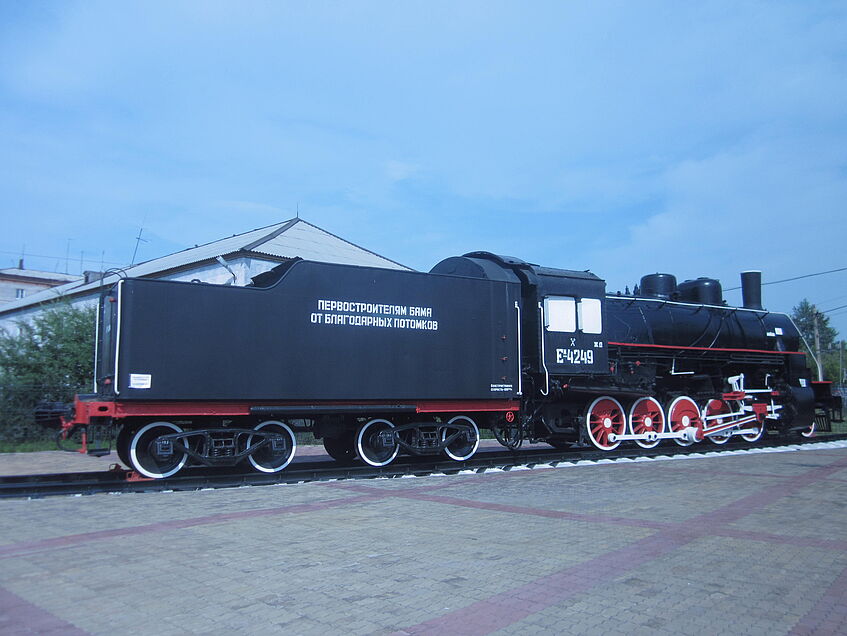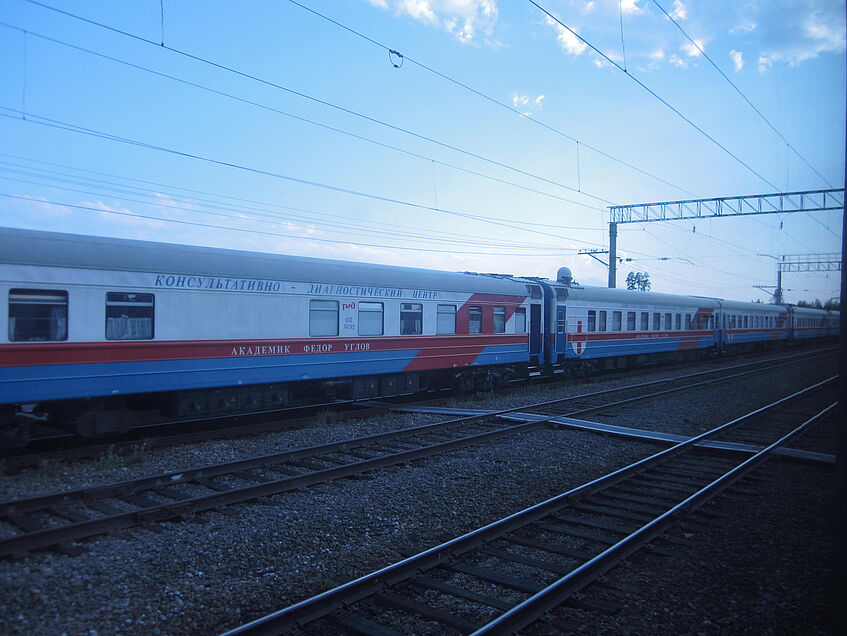The rhythms of trains and everyday life along the BAM
The main aim of this component's fieldwork conducted by Vera Kuklina was to study the impact of the railroad and its maintenance on the mobilities and everyday life of individuals and households working and living in the settlements and passengers travelling along the Baikal-Amur Mainline.
The field sites included Ust-Kut, Tynda, and Severobaikalsk, as well as on the passenger trains running between these BAM cities. Part of the fieldwork, including key interviews in local municipalities and the Russian Railroad Company's offices in Tynda and Severobaikalsk, was conducted in collaboration with Peter Schweitzer and Olga Povoroznyuk.




Fieldwork Questions
The field studies focused on the rhythms of the BAM railroad and the following related questions:
- Mobilities and division of work between the railroad and households among the railroad workers
- Legacies of memories and experience of former BAM workers in current exploitation of the BAM railroad and construction of intersecting social identities.
- Mobilities and immobilities induced by the access to and schedules of passenger trains running along the BAM
- Sustainability in the settlements with the dominating transportation industry in connection with economic diversification and social diversity.
Fieldwork and dissemination activities
The Fieldwork conducted in summer 2016 included individual in-depth and focus group interviews with local residents, former BAM builders, officials, workers of the Russian Railroads Company; mobility survey questionnaires focusing on travel patterns and satisfaction with the existing infrastructure; collection of archival and statistical demographic data, and municipal reports and programs of socio-economic development that filled the gaps in publicly available data from the municipal Internet-sites. In the course of the fieldwork, 46 interviews with local residents and passengers on the, train were recorded.
Preliminary fieldwork results
Preliminary fieldwork results
- The Soviet plans for extraction of natural resources along the BAM region have not been fully realized. As a result, the budgets and jobs of local municipalities are provided mainly by the railroad, resulting in the fact that Tynda and Severobaikalsk are listed as single industry towns. Current projects of the development of extractive industry with the use of long-distance commuting and reorganization of RZD (Russian railways) re-emphasize the masculine nature of work in the North. While the LDC is practically male-dominated sphere of employment, growing workload and irregular schedules in RZD also limit employment opportunities for the individuals other than young single physically strong and healthy men.
- Due to their little dependence on natural conditions, trains are the most reliable means of transportation. Nevertheless, the railroad male workers, constituting the most mobile group, prefer other means of transportation for recreation and tourism purposes.
- Following the reforms at the RZD responsibility for providing commuter intercity train services have been delegated to the regional government. In the case of such an economically unstable region as the Republic of Buryatia, it means that fewer commuter trains are available to the local residents, who now have to use more expensive long-distance passenger trains.
- Lack of healthcare and extreme climate conditions also have more impact on women as the main caregivers to children and elderly. Closures of schools and healthcare facilities together with higher rates for commuting push them to move from smaller settlements to bigger ones. Opposition where home is related to the tradition and work - to modernity, is reversed in the Russian North, where anthropologists observe relations of women to the settlements and modernity while the men - to the forest and traditional activities.
The rhythms of trains and gendered division of labour along BAM, July 2017
The main aim of this component’s fieldwork conducted by Vera Kuklina was to study the impact of the train schedule on the settlements, railroad workers, and passengers travelling along the Baikal-Amur Mainline. The field sites included Ust’-Kut and Severobaykal’sk, the passenger trains running between these BAM cities, and the village Kholodnoe. The fieldwork in the village Kholodnoe, including key interviews in local municipality, was conducted in collaboration with Olga Povoroznyuk.
The field studies focused on the rhythms of the BAM railroad and the following related questions:
- Mobilities and division of work between the railroad and households among the railroad workers
- Mobilities and immobilities of local residents induced by the access to and schedules of passenger trains running along the BAM
- Forms of dependencies of local businesses on the railroad regulations and schedules.
Fieldwork and dissemination activities included individual in-depth interviews with local entrepreneurs, former BAM builders, officials, workers of the Russian Railroads Company; mobility survey questionnaires focusing on travel patterns and satisfaction with the existing infrastructure; collection of statistical and economic data, and municipal reports and programs of socio-economic development.
In the course of the fieldwork, 32 interviews with local residents and passengers on the train were recorded and 40 questionnaires were filled.
Preliminary results of the fieldwork:
- Work and travel by trains on Moscow time affect regimes of work and rest of the railroad workers not only on trains, but also in the railroad offices. For the workers on the tracks, the seasonal changes and “windows” between trains have more impact on the regime of work.
- The schedules of passenger trains have significant impact on business activities of entrepreneurs located near the train stations and at the train stations. Particularly, the work of cafes, kiosks, petty-traders and taxi drivers is more oriented on coming and going passengers of trains. Meanwhile, in the places where the railroad is the only reliable way of transportation small and medium entrepreneurs use baggage wagons of the passenger trains for delivery of goods that form dependency on duration of stop, location of the baggage trains on the railway platform. However, with growing fares on the railroad, entrepreneurs and passengers look for other ways of transportation, sometimes at the expense and risk of their own safety (for example, using poorly maintained automobile road along the BAM railroad).
- Stations of departure and arrival of trains, duration of travel, frequencies and duration of stops form temporality of passengers and train attendants’ movement and the character of their interactions. While the train attendants have a list of instructions regulating amount of services and ways of conduct with passengers, there is limited information about the use of the wagon’s facilities for the passengers. The forms and norms of conduct among passengers are regulated informally, based on ‘common knowledge’. For the passengers without experience of travel on the Russian trains, there are challenges for adaptation and more comfortable travel.
- Gendered division of labour on the railroad remains one of the fields of the male domination: most of the positions with higher wages and management roles are occupied by men. In rare cases when a high position in taken by a women, her language, even in the first person, is still dominated by male grammatical forms (in Russian: «Сам сделал, сам принял, сам отправил»). Generally, female interviewees of older generation and those without children show more support of the existing hierarchies. The “traditional” division of labour is contested by younger generation: girls are more interested in studies of technical disciplines of the railroad education than earlier.
